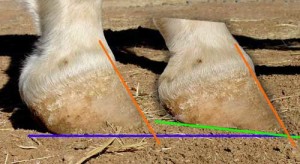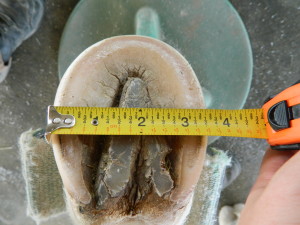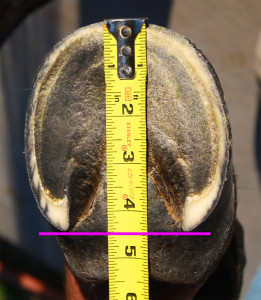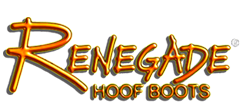One of the easiest ways to ensure boot fitting and sizing success is to start with a well-shaped barefoot hoof, measuring with a couple of days of a fresh trim, and having a clean hoof. Ragged edges, missing hoof wall, flare, and mud will all potentially give an inaccurate measurement. The more accurate the measurement, the better chance of getting the correctly sized boot.
Renegade® Hoof Boots are designed to fit a well-trimmed, balanced, naturally barefoot-trimmed hoof. Long toes, a very low toe angle, too upright of a hoof angle, high heels, flare, and other deviations from a natural barefoot trim will all negatively affect the performance of the Renegade® Hoof Boot.

Accuracy of the actual measurements is also critical. When measuring, it may be easier to obtain a more exact measurement by using a metric measurement, preferably millimeters. When measuring in inches, there is a tendency to “round up” or “round down” to the closest significant measurement, or when trying to match up to the closest measurement on the sizing chart.

The location of where you’re taking the measurement is also very important. On the width, it should be taken at the widest point of the hoof. Renegade® Hoof Boots are designed so that the widest point of the boot is at the approximately middle point of the boot, and that is what is listed on the sizing chart. If your horse’s hoof conformation varies greatly from that, contact us directly and email us photos of the hooves with the tape measure showing the hoof measurements and we can help direct you to the most-appropriate boot size.
On taking length measurements, you want to ensure the entire weight-bearing surface of the hoof is covered by the sole plate of the boot. A well-trimmed hoof should have the frog and point of heel in alignment, forming the “buttress line” of where to take the length measurement.

Sometimes the frog and point of heel will not be in alignment, and the frog sticks out past the heels. This is not an ideal hoof conformation and an indication that the heel are too long — most likely they are low, but underrun, and should be address through proper trimming before ideal boot fit and function can be obtained. Should measurements be taken on a hoof conformation such as this, the length measurement should go all the way to the rear of the frog — whatever part of the hoof that makes ground contact when the hoof is bare should be taken into account when measuring.

One more thing to keep in mind on hoof length versus boot length measurement is that the toe shape can affect actual boot length requirements, as a hoof with a large toe bevel or over-accentuated mustang roll will not seat all the way forward in the boot, meaning the hoof may sit in the boot further back than the actual length measurement would indicate. This is something to keep in mind when determining if your horse needs one of the Cutback Options on the boot length, in which a small portion of the sole plate is trimmed off the boot in order to more closely match the horse’s hoof length.
Our goal is to help you achieve successful boot fit and performance, so if you have any questions, please contact us and we would be happy to help you with any sizing, fitting, or troubleshooting questions you may have.
